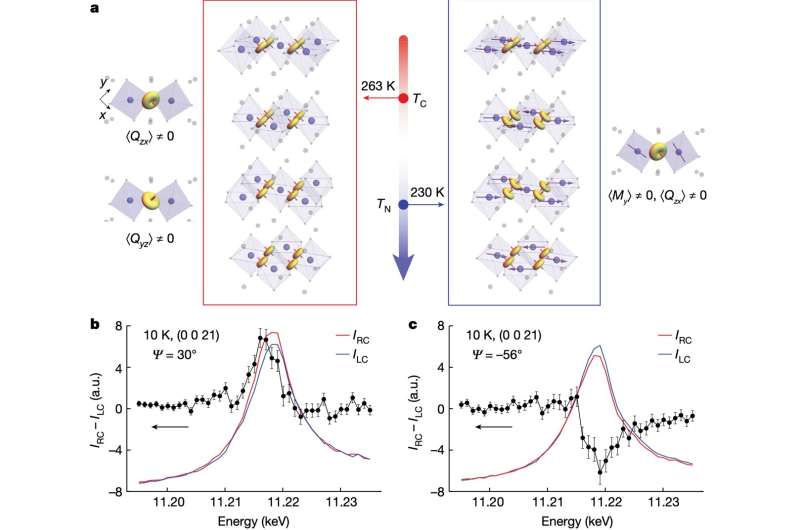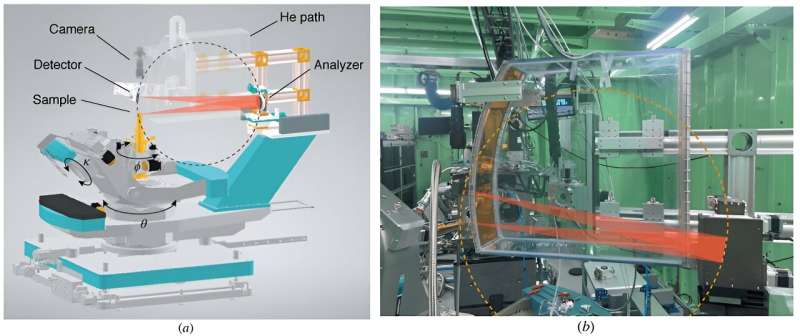This article has been reviewed according to Science X's editorial process and policies. Editors have highlighted the following attributes while ensuring the content's credibility:
fact-checked
peer-reviewed publication
trusted source
proofread
Discovery of magnetic liquid crystal: First direct observation of spin quadrupole moments in a spin-nematic phase

Liquid crystal is a state of matter that exhibits properties of both liquid and solid. It can flow like a liquid, while its constituent molecules are aligned as in a solid. Liquid crystal is widely used nowadays, for example, as a core element of LCD devices.
The magnetic analog of this kind of material is dubbed the "spin-nematic phase," where spin moments play the role of the molecules. However, it has not yet been directly observed despite its prediction a half-century ago. The main challenge stems from the fact that most conventional experimental techniques are insensitive to spin quadrupoles, which are the defining features of this spin-nematic phase.
But now, for the first time in the world, a team of researchers led by Professor Kim Bumjoon at the IBS Center for Artificial Low-Dimensional Electronic Systems in South Korea has succeeded at directly observing spin quadrupoles. This work was made possible through remarkable achievements over the last decades in synchrotron facility development.
The IBS researchers focused their study on square-lattice iridium oxide Sr2IrO4, a material previously recognized for its antiferromagnetic dipolar order at low temperatures. This study newly discovered the coexistence of a spin quadrupolar order, which becomes observable through its interference with the magnetic order. This interference signal was detected by 'circular-dichroic resonant X-ray diffraction,' an advanced X-ray technique employing a circularly polarized X-ray beam.

Further verification of this discovery came through 'polarization-resolved resonant inelastic X-ray scattering', where the magnetic excitations were revealed to significantly deviate from the behaviors anticipated for those in conventional magnets.
To complete these experiments, the researchers in South Korea have collaborated with Argonne National Laboratory in the US to construct a resonant inelastic X-ray scattering beamline in Pohang Accelerator Laboratory over the last four years.
Last but not least, the researchers used a series of optical techniques, including Raman spectroscopy and magneto-optical Kerr effect measurement, to show that the formation of the spin quadrupole moments occurs at higher temperatures than the magnetic order. Within this temperature range, the iridium oxide has only spin quadrupole moments but no magnetic order, realizing a spin-nematic phase.
Taken together, this is the first direct observation of the spin quadrupole moments in a spin-nematic phase.

"This research was feasible because the infrastructure and capabilities of X-ray experiments in South Korea had reached a globally competitive level," says Prof. Kim Bumjoon, corresponding author of this study.
"The discovery of the spin-nematic phase also holds significant implications for quantum computing and information technologies," adds Prof. Cho Gil Young, a co-author of this study and professor at Pohang University of Science and Technology.
Another exciting aspect of the spin-nematic phase is its potential for high-temperature superconductivity. In the spin-nematic phase, the spins are highly entangled, which was suggested by physicist P. W. Anderson as a critical ingredient for high-temperature superconductivity.
Furthermore, given that iridium oxide Sr2IrO4 has been extensively studied because of its striking similarities with the copper-oxide high-temperature superconducting system, which fuels a growing interest in this material as a potentially new high-temperature superconducting system, as well as its relation to the spin-nematic phase.
The findings are published in the journal Nature.
More information: B. J. Kim, Quantum spin nematic phase in a square-lattice iridate, Nature (2023). DOI: 10.1038/s41586-023-06829-4. www.nature.com/articles/s41586-023-06829-4
Journal information: Nature
Provided by Institute for Basic Science





















